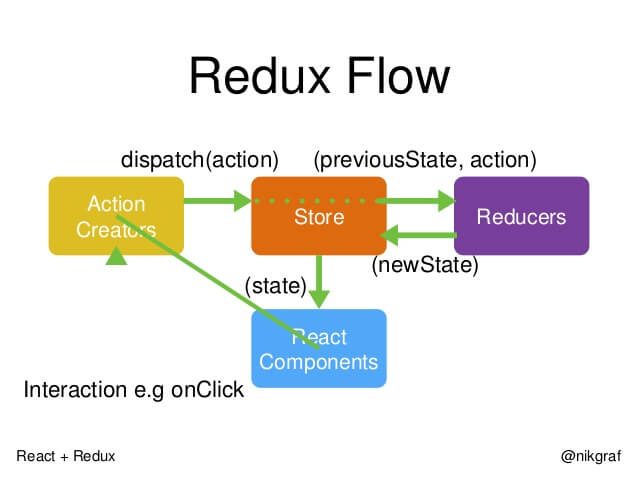Redux 基础概念
1. 安装依赖
npm i redux, react-redux -S
2. 安装 Chrome 调试插件
React Develop Tools
Redux DevTools
Redux DevTools 设置:
const store = createStore(
reducer,
window.__REDUX_DEVTOOLS_EXTENSION__ && window.__REDUX_DEVTOOLS_EXTENSION__()
);3. createStore 源码
以下是 redux 中 createStore 代码的简化版:
function createStore (reducer, preloadedState, enhancer) {
let currentReducer = reducer // 存放 reducer
let currentState = preloadedState // 闭包,存放 state
let currentListeners = []
let nextListeners = currentListeners // 存放所有的 listener
let isDispatching = false
function getState () {
return currentState // 返回闭包中 state 的结果
}
function subscribe (listener) {
nextListeners.push(listener) // 新增 listener
return function unsubscribe () {
const index = nextListeners.indexOf(listener)
nextListeners.splice(index, 1) // 移除 listener
}
}
function dispatch (action) {
if (isDispatching) {
// 防止在 reducer 中再次执行 dispatch
throw new Error('Reducers may not dispatch actions.')
}
try {
// 执行 dispatch 时,dispatch 为 true
// 相当于锁住了该状态,比如,防止在 reducer 中再次执行 dispatch
isDispatching = true
// 将闭包的 state, 和 action 进行计算,从而更新 state
currentState = currentReducer(currentState, action)
} finally {
isDispatching = false
}
// 在 dispatch 之后,通知所有的 listener
const listeners = (currentListeners = nextListeners)
for (let i = 0; i < listeners.length; i++) {
const listener = listeners[i]
listener()
}
return action
}
dispatch({ type: `@@redux/INIT+随机数` })
return {
dispatch,
subscribe,
getState
}
}即实际上就是通过闭包创建 state,同时对外暴露更新 state 数据( dispatch 方法)和获取 state 数据( getState 方法 ) 的实现。
4. 简单示例
如上所示,就是简单的 redux demo,来总结几点:
reducer 就是一个函数,接受当前的 state 和 action,返回新的 state. 可以在 reducer 中定义 state 初始值。
action 是一个对象,应该有 type 和 payload 两个属性,分别用于描述这是什么类型的 action,以及 该 action 携带的值。其中 type 是必填的。对于 action 还有一个社区规范, action 社区规范
一个组件被 connect 之后,props 上就会有
dispatch方法,该方法的使用示例:dispatch(action)如果一个组件需要接受 redux 中的 state,必须定义
mapStateToProps,mapStateToProps的第二个参数ownProps为组件自身的 props。 此时当 redux 中的 state 发生变化,props 就会发生改变。
5. 什么是 Action Creator
在之前的示例中,我们这样定义 action
这样的问题在于,有多少个 action 就需要定义多少个这样的变量。于是就诞生了 Action Creator
即,ction Creator 就是一个函数,用于创建 action。
6. Reducer
可能会好奇,为什么这个函数叫做 reducer 呢? 因为,这个函数可以作为 数组 reduce 方法的参数
6.1 reducer必须是纯函数
因此 Reducer 函数里面不能改变 state,而必须返回一个全新的对象:
7. Reducer 的拆分
在简单示例中,redux state 是一个简单值,state = 0
在实际开发中, state 可能是一个对象: state = { foo: xxx, bar: xxx }
示例代码:
在上面这个示例中, foo 和 bar 是 state 的两个根属性(实际开发中,可能对应两个子组件,子页面),其实是互不影响,但是他们的 Reducer 却写在了同一个文件中,在大型应用中,必然导致 Reducer 函数非常庞大
于是我们尝试将 Reducer 拆分为两个小文件:
即通过将对应的 子 state,传入到子 reducer 中,从而更新根 state.
redux 内部也暴露了 combindReducers 来组合 子 reducer:
注意,默认 state 的定义划分到子的 reducer 里了
同时,如果 fooReducer 改为 foo, 那么可以简写:
8. 工作流程梳理
以下是 redux 的工作流程图:

store 通过 matchStateToProps,将数据更新到 React Component 上
组件点击时,
dispatch( actionCreator(xx) ), 其中actionCreator(xx)会生成一个 action当 dispatch(action) 时,redux 内部会将 (state,action) 作为参数传入到 Reducers 里
Reducers 通过执行完,返回新的 state。此时 store 通过 matchStateToProps 再更新 React Component
参考文档
Last updated
Was this helpful?